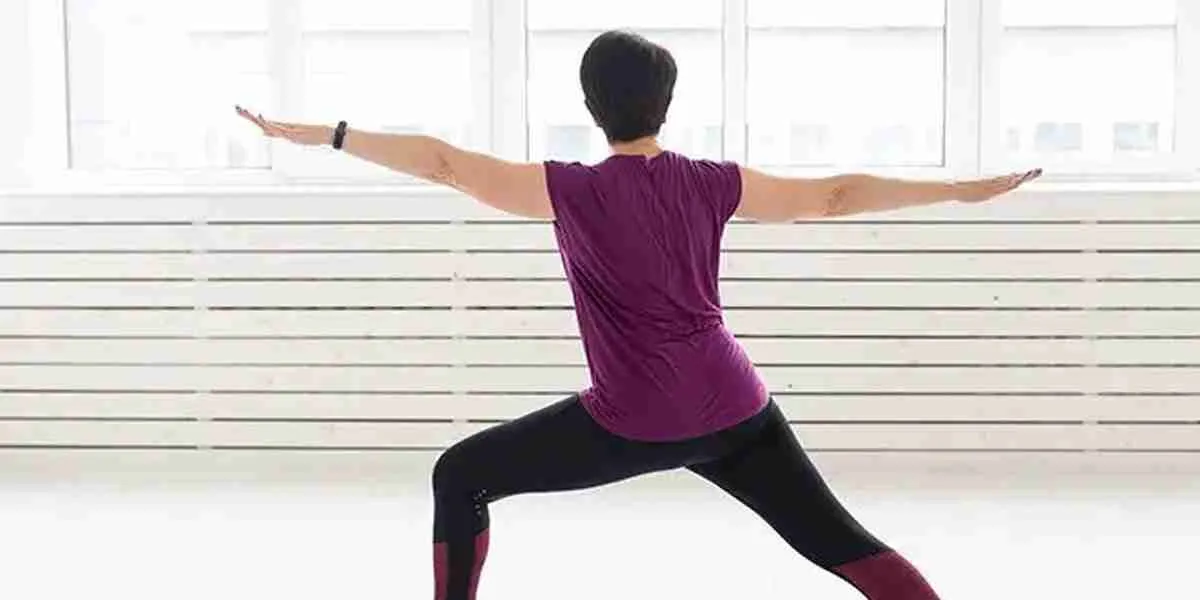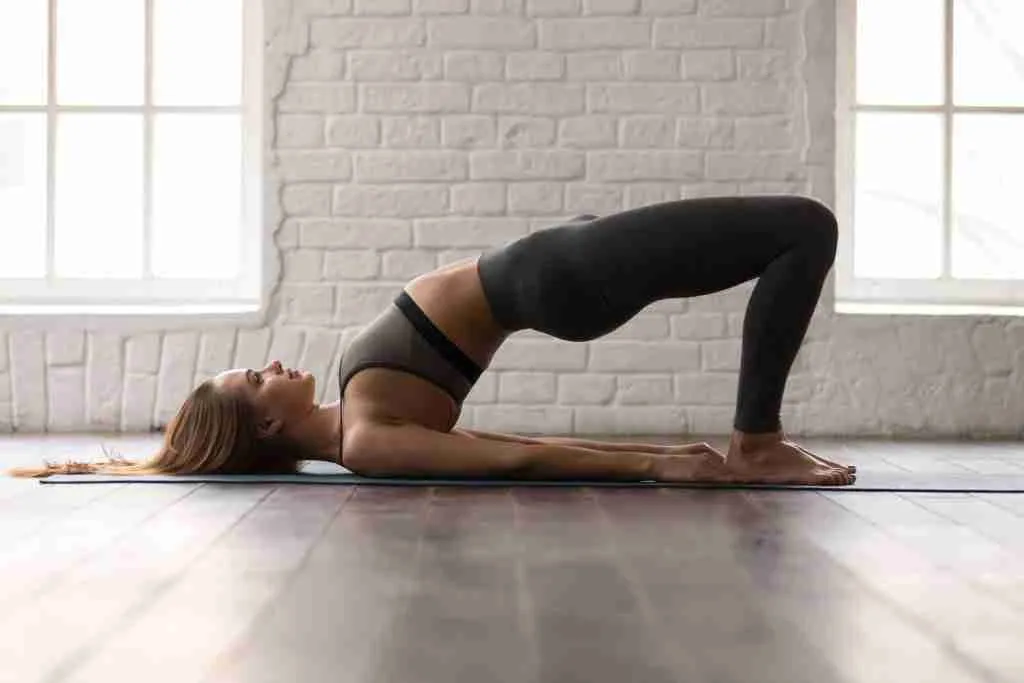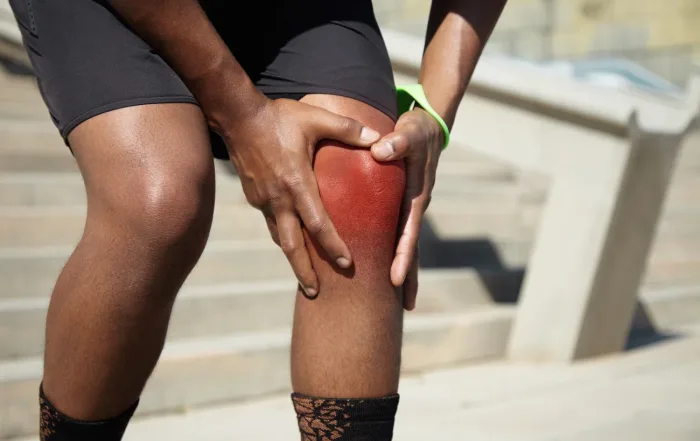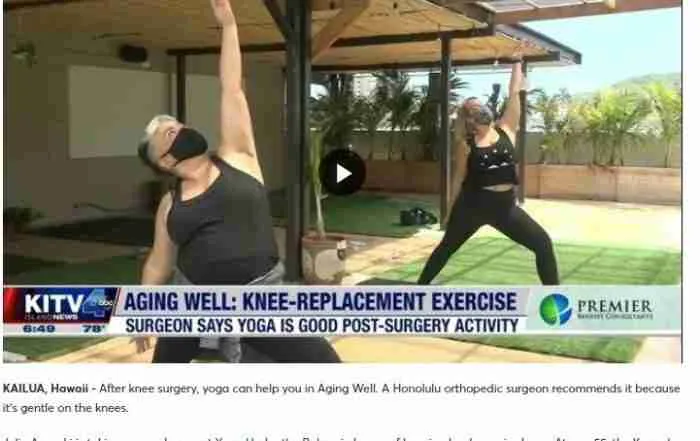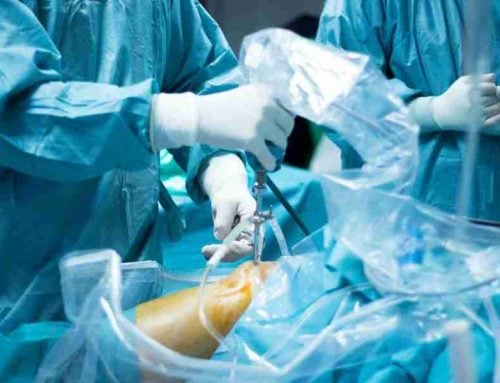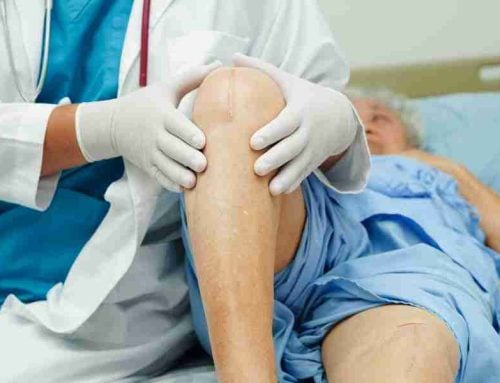Table of Contents
After you have had knee replacement surgery and you have been cleared for physical activity, you may want to incorporate yoga into your recovery regimen. Yoga is a wonderful resource when it comes to developing and improving physical strength, flexibility, and mobility. Due to its therapeutic nature, yoga can be practiced as part of a healing routine after surgery, a training component for conditioned athletes, and also a tool for relaxation and meditation. Whatever the intention, yoga allows the practitioner to tap into many aspects of the human condition. Yoga guides the individual toward a greater awareness of self so that she or he can reach their highest potential. This can be especially useful when recovering from surgery.
One of the first things you’ll be advised to do after knee replacement surgery is regaining mobility and strength. Having full function of the knee joint and appropriate supportive strength from the quadriceps, hamstrings, and calf muscles are essential for a full recovery. Your goal is to straighten and bend your leg at an effective range of motion so you can regain your independence and return to the things that you love to do.
Adding the following yoga postures to your therapeutic regimen can be beneficial in your journey:
- Warrior Two
- Tree Pose
- Bridge Pose
- Child Pose
- Savasana
Another thing to consider is the intensity at which you practice these poses. If you’re a regular yogi and have previously engaged in a dynamic practice, you will need to work at a lower rate of intensity to ensure recovery and no additional injury. The described yoga postures can be performed with modifications and assistive yoga props to ensure the necessary safety of your body.
Warrior Two
Warrior Two is a lunging yoga posture that can strengthen the quadriceps. This is important because you want to build strength around the supporting muscles that surround the knee joint.
Begin this posture by standing in Mountain Pose: stand tall with both feet about hip-distance apart. (If you need something to help stabilize your posture, like a wall, chair, walker, etc., please feel free to use one.) While keeping the working foot rooted (let’s say it is the left leg), step the right foot back so you’re creating a wide stance. Bend your left knee while keeping your knee pointing in the same direction as your toes. Keep your right leg as straight as possible without locking the knee joint.
As you step your right foot back, turn the foot outward just enough to maintain alignment with your right knee and to establish a strong base. Do your best to keep the center of gravity at your pelvis; you do not want to put added pressure on your left knee. As you work your way into this lunge, align your left knee over your ankle bone or heel. Having the knee aligned too far forward will again put too much pressure on the joint. And finally, your left thigh can be just above parallel with the floor; this should place enough tension in the quad and hamstrings muscles to stabilize your pose.
Even at an angle, your right foot should press firmly into the yoga mat. Allow some pressure to reach the outside edge of the foot. By doing so, your right leg muscles will engage, too, thereby creating a stable posture. For a more classic representation of the pose, extend your arms out over your legs. They will be parallel to the ground. But if you need to brace yourself while holding this posture, use the wall, chair, or walker to maintain your balance. Hold the pose for 10 slow deep breaths. Be sure to practice the pose on the other side for an effective balance of strength.
Tree Pose
This is a standing balancing posture that will aid in the recovery of your knee replacement. Because you will be balancing on one foot, you may want to stand near a wall or high-backed chair to assist your posture. Stand with your working side nearest the wall (let’s start with the left side) with both feet planted into the ground. Gently shift your weight into your left foot and root firmly into the floor to activate your thigh muscles. Engage your core by activating your abdominal muscles with an exhale. Once stable, lift your right foot off the ground. It is suggested that you flex this foot to keep this lifted leg active. Turn the lifted knee outward: 45 degrees is sufficient for this pose. Place the foot on the inside of the standing leg. Hold the posture for 10 to 20 breaths. Once complete, perform the posture on the other side.
Bridge Pose
Another yoga posture to practice to regain strength in your leg muscles is Bridge Pose. This is a backbend, but you can perform the pose with a prop and still effectively activate your glutes, hamstrings, and hip flexors. These are areas of the body that will continue to support the recovery of your knee replacement.
Start the posture by lying on your back. Bend your knees with your feet firmly planted into the ground. Ideally, your knees will be aligned directly over your ankle bones. But if the recovering knee does not yet have that range of motion, step both feet slightly forward. As needed, step your feet wider on your yoga mat being sure your toes are pointing in the same direction as your knees. This will provide a greater range of motion when you eventually move into the posture while also maintaining safe alignment in your knee joints. You may consider practicing this pose with your toes touching a wall to create better leverage and stability. On an exhale, lift your hips into the air and hold this posture for 10 to 20 breaths. Lifting and holding yourself up will engage all the leg muscles surrounding your knee joints.
To assist this posture, you can bend your elbows at 90 degrees and press your triceps into the floor to help maintain the lifted body. If this feels at all like a strain or requires too much effort in your legs, slide a yoga block underneath you to sit on. This will keep the hips lifted while being able to relax the body after several rounds of breath. For example, inhale to fill up your lungs, then exhale to lift your hips off the yoga block. Take three more breaths, then lower yourself down to the block again.
Recovery after knee replacement surgery can also be stressful. You may not be making the progress you desired; you may feel like it is taking a long time to reach your goals to engage in normal activities again. Stress under these conditions may hinder your recovery. Yoga can also help in these situations. Not only can you practice yoga poses to gain strength and mobility, but you can also practice mindfulness meditation and intentional breathing to help with the stress associated with post-surgery recovery.
Child Pose
This is a yoga posture that can still afford you greater range in your recovering knee, while also providing relaxation. You will need several props for this variation of the pose: a blanket and a large cushion.
Start by coming to your hands and knees. Use a folded blanket to pad your knees. Place a large cushion or yoga bolster between your legs or along your calves. Slowly sit back onto the cushion while extending your arms forward onto the ground. You can rest your forehead on the ground or another soft surface. Depending on the range of motion you have in your knees, you may not be able to sit all the way back onto your heels. Keep your hips lifted as high as needed (using your cushion for support) until you can comfortably relax into the posture. As you are able, hold this pose for several minutes. Focus on taking slow deep breaths to feel a sense of calm through your mind and body.
Savasana
After any yoga practice, you may finish in Savasana. Simply lie on your back on your yoga mat for several minutes to allow your entire body to relax. Sometimes, though, lying on your back with your legs extended out in front of you is not absolutely comfortable. You may require some added support for full ease in the body and mind. Consider placing a pillow, bolster, or rolled up blanket underneath your knees. This will keep a soft bend in your knees as well as relax your lower back so you rest comfortably. Take slow breaths in and out to allow stressful feelings and thoughts to dissipate.
Start with these modified yoga postures post knee replacement surgery to regain mobility, strength, flexibility, and relaxation. Use the recommended props and variations to ensure safety and a more rapid recovery. Take your time before you add more intensity to the practice. Watch and feel for your physical improvements before advancing in your continued yoga practice.
The Role of PRP in Treating Sports Injuries for Athletes
In the competitive world of sports, athletes constantly push their bodies to the limit, which, unfortunately, often leads to injuries. The quest for effective and swift recovery solutions is ongoing from tendonitis and [...]
Yoga After Knee Replacement Surgery
To regain your strength after a knee replacement surgery, turn towards yoga and practice these poses that work wonders to win back your mobility and strength.
Yoga after Hip Replacement
Can you do Yoga After Hip Replacement Surgery? 5 Poses to Get you Started [no_toc] (808)439-6201 The Queen’s Medical Center POB [...]
Talk with Your Knee Replacement Surgeon Today!
Choose Dr. Morton as your Knee Replacement Surgeon Today!
- Board-certified, Fellowship Trained Knee Surgeon
- Experienced Orthopedic Surgeon
- Nonoperative and operative treatments available
- High success rate in rapid-recovery techniques
- Minimally invasive surgery
- Well-versed with yoga techniques for recovering from knee replacement surgery
- Fellowship-trained and specialist in knee replacement surgery
- Understands your desire to get back to activity

